Ommanipemewhum.
The mantra of the God of compassion, Chenresig, the one with 1000 hands and 1000 eyes, 11 heads. He has a big job showing compassion to all.
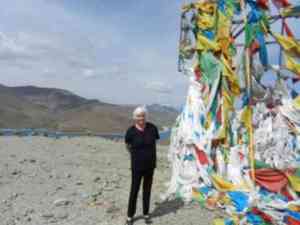 |
| 1. Happy at 15,776 |
Yesterday was a full day in a slow Toyota four-wheeler, horn beeping at every dog, cat, Tibetan, car, sheep, wagon – and that’s hard on the nerves. The driver and the guide knew what they were doing. Every so often there is a radar-type situation, energized by solar heating. I’m impressed by the use of solar panels in Tibet. I kept focus on my needlepoint, a hiker bear as we headed for an important pass of 15,778 feet. That height requires a huge deep breath, often. I was so worried, after an hour of dramatic bobby-pin cures, as I hung on to the handle above the door, that I’d lose my fancy breakfast from the St. Regis Hotel in Lasha, the last chance for a familiar meal.
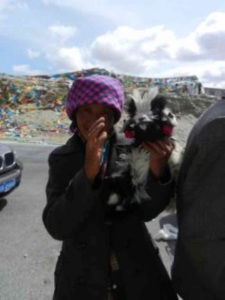 |
| 2. Tibetan woman with her baby goat |
Altitude hasn’t ever been a stretch for me. If one takes it easy, doesn’t rush, and drinks gallons of water, it shouldn’t be a problem. When we left about 12,000 feet in Lasha, I was good. We would travel over three high passes of barren mountain to get to the next night stop, the 2nd largest city in Tibet, Shigatse. The first pass was the highest and I got out my IPhone for the Elevation App, and followed our progress. When we drove around an enormous rock and arrived at 15,778 feet, we drove under a confused mass of prayer flags flying desperately in the wind to get those prayers to God. There were a few tourist buses but we all took in the most incredible view of snow covered Himalayas in the distance and an enormous turquoise lake far below. Thank you God.
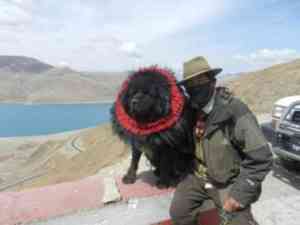 |
| 3. Tibetan Mastiff with his boss |
But to boot, there was funky entertainment of a sort. First a Tibetan street seller woman insisted I pet her hairy baby goat. I did. Pay up. Ok. Then a Tibetan man with a scarf covering his face (this is the norm – most people wear either medical masks or bandanas to stop the dust and smoke from entering one’s face), came up with a medium sized black Tibetan mastiff on a rope. The poor dog wore an enormous red collar around him and he won me over quickly. The dog was patient. He listen to my friendly pats and let me be photographed with him. More Yen paid, and I was still breathing and not dizzy in the high altitude.
Then I checked another experience off my bucket list. I was able to sit on a Yak. Poor yak. Decked out in ribbons and curls. White. Well, really scraggly dirty white. White is supposed to be sacred. I had my doubts. I put my sandal in the one stirrup and three guys (Nema, the Yak owner, and our drive) lifted me into the Tibetan saddle as if I wouldn’t make it on my own. Yaks are not tall. But I spared them my history mounting horses, camels, elephants. The altitude was too high for much conversation. No one spoke English so “I can do it” meant nothing to Tibetan ears.
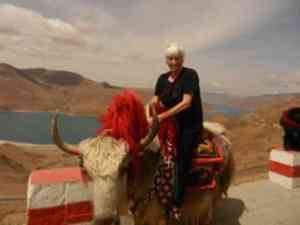 |
| 4. Finally, a Yak to ride for a second |
From here on out, it’s Yak country. Yak pull the plows in fields of barley. Their hair and leather decorates very tall prayer flag poles. Their milk is tasty and made into yak cheese – not the most appealing flavor – something more like sweet yak dung that was burned for warmth when I went to Everest base camp four years ago. Jim and I tried yak cheese cake and couldn’t get rid of the taste for a whole day. Yak butter is a major business as it is the ingredient used by monks to make their elaborate butter sculptures, offering dedicated to the three primary Buddha figures (past, present and future) and other accessory Buddhas. (It’s all really the same god.) Then there is yak tea drunk by the monks, and yak leather shoes. There is nothing wasted.
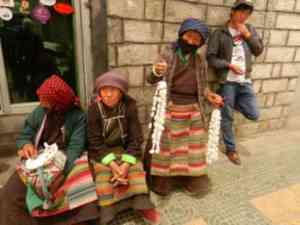 |
| 5. Women selling Yak cheese |
Yesterday’s main point to visit was Gyantse which houses a famous stupa Gyantse Kumbum. This town has a very high fort which the British inhabited in 1904, a battle led by Sir Francis Younghusband on Lasha. He slaughtered 700 Tibetans in four minutes.
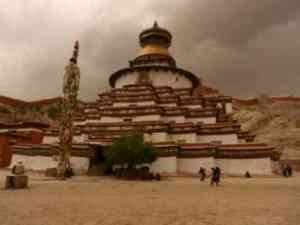 |
| 6. Gyantse Stupa |
However, our focus was on the Stupa, it has 13 floors and as we crawled up stairs and into the big assembly space, the monks dressed in the yellow hats (indicating they belong to the 14th Dalai Lama’s group), were chanting and beating enormous religious drums. We wandered through the monastery taking pictures, after paying, of course, of statues decorated with Katas and butter lamps and butter sculptures and anything else worshipers brought to them. There were three huge mandelas in sand on the floor, well protected from the public and impossible to photograph. The grounds were full of pilgrims making Koras around various buildings of the Stupa and finally when Nema and his wife had acknowledged all the holy areas, we headed a few more miles to our hotel in Shigatse. It was a giant China-style building. The bed was a slat of wood (king size) I promise you, and one duvet, which I used to pad the wood. Good heavens. I was so exhausted after a real Tibetan dinner of noodles and veggies and momos that I just gave in. I could no longer fall back on my “bfs” CNN and BBC. Alas. All TV was Chinese.
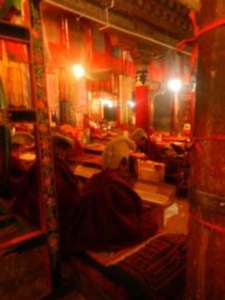 |
| 7. Monks in yellow hats, chanting |
Some notes. Brush teeth only with bottled water in Nepal and Tibet. Also, Himalayan red salt lamps don’t exist here. Also, acupressure began in Tibet. Somehow it is related to the idea of sky burials. There are no cemetaries. There are no major trees in Tibet, my guide said, except the saplings that have been planted over the last few years to help stop the sand and dust from making towns unpleasant. Therefore, there has been no wood to be used for cremation as a burial form.
However, there’s a different burial process. Sky burials. They seem to relate the Native American Indian’s tradition of dealing with death. When a person dies, the high lama comes to the house to pray and relies on astrology to find an auspicious day for burial. This same high Lama releases the soul in a ceremony on that auspicious day. The soul is released through the head and is gone. Then the lama cuts the body into small pieces as that will be fed to the Himalayan griffins. For seven weeks on the day the person died (for instance on a Monday) the family and monks preform a Puja, a holy ceremony for which butter lamps and prayers are offered, while the body is in what is called the intermediate state. Then after 49 days, the body is fed to the birds. And the earth is clean. It’s recycling at its best.

Audrey,
Just when we thought you had found Shangri-La, you gave us iinformation that brought us back to reality. Now, you are riding a Yak at 15,776 feet, climbing up 13 floors of narrow stairs at this high altitude and sleeping on a board.
Wow! Is this some sort of cleansing or purification process. If that is what you are doing, then come home, because you don’t need either of those processes. Just think! You can eat real food, ride in an airconditioned vehicle and sleep in a soft, comfortable bed! Also, no one will cut you up and feed you to the griffins or the birds.
Your are in our prayers.
Lots of love to you,
Geraldean and Judge
Audrey,
Can you bring the Yak and the Tibetan Mastiff home with you?
If so, we’ll keep them in our back yard. Both will receive a lot of attention and plenty of food.
Love you,
Geraldean and Judge
Audrey,
Can you bring the Yak and the Tibetan Mastiff home with you?
If so, we’ll keep them in our back yard. Both will receive a lot of attention and plenty of food.
Love you,
Geraldean and Judge
Loving your blog-I was in tibet with a group 6 years ago-so fascinating!
Agnes Stark